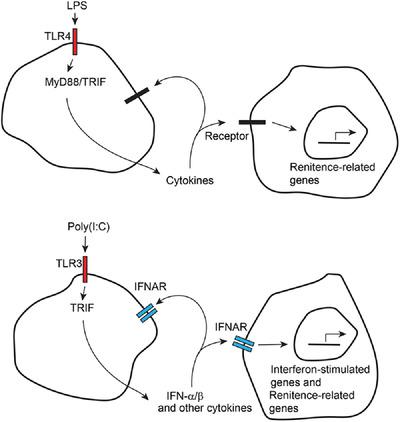当前位置:
X-MOL 学术
›
J. Leukoc. Biol.
›
论文详情
Our official English website, www.x-mol.net, welcomes your
feedback! (Note: you will need to create a separate account there.)
Macrophage inflammatory state influences susceptibility to lysosomal damage
Journal of Leukocyte Biology ( IF 3.6 ) Pub Date : 2021-07-14 , DOI: 10.1002/jlb.3a0520-325rr Amanda O Wong 1, 2 , Matangi Marthi 1 , Amanda Haag 1 , Irene A Owusu 1, 3 , Christiane E Wobus 1, 2 , Joel A Swanson 1, 2
Journal of Leukocyte Biology ( IF 3.6 ) Pub Date : 2021-07-14 , DOI: 10.1002/jlb.3a0520-325rr Amanda O Wong 1, 2 , Matangi Marthi 1 , Amanda Haag 1 , Irene A Owusu 1, 3 , Christiane E Wobus 1, 2 , Joel A Swanson 1, 2
Affiliation

|
Macrophages possess mechanisms for reinforcing the integrity of their endolysosomes against damage. This property, termed inducible renitence, was previously observed in murine macrophages stimulated with LPS, peptidoglycan, IFNγ, or TNFα, which suggested roles for renitence in macrophage resistance to infection by membrane-damaging pathogens. This study analyzed additional inducers of macrophage differentiation for their ability to increase resistance to lysosomal damage by membrane-damaging particles. Renitence was evident in macrophages activated with LPS plus IFNγ, PGE2, or adenosine, and in macrophages stimulated with IFN-β, but not in macrophages activated with IL-4 or IL-10. These responses indicated roles for macrophage subtypes specialized in host defense and suppression of immune responses, but not those involved in wound healing. Consistent with this pattern, renitence could be induced by stimulation with agonists for TLR, which required the signaling adaptors MyD88 and/or TRIF, and by infection with murine norovirus-1. Renitence induced by LPS was dependent on cytokine secretion by macrophages. However, no single secreted factor could explain all the induced responses. Renitence induced by the TLR3 agonist Poly(I:C) was mediated in part by the type I IFN response, but renitence induced by Pam3CSK4 (TLR2/1), LPS (TLR4), IFNγ, or TNFα was independent of type 1 IFN signaling. Thus, multiple pathways for inducing macrophage resistance to membrane damage exist and depend on the particular microbial stimulus sensed.
中文翻译:

巨噬细胞炎症状态影响溶酶体损伤的易感性
巨噬细胞具有增强其内溶酶体完整性以抵抗损伤的机制。这种被称为诱导性 renitence 的特性以前在用 LPS、肽聚糖、IFNγ 或 TNFα 刺激的小鼠巨噬细胞中观察到,这表明 renitence 在巨噬细胞对膜损伤病原体感染的抵抗力中的作用。本研究分析了巨噬细胞分化的其他诱导剂增加对膜损伤颗粒对溶酶体损伤的抵抗力的能力。在用 LPS 加 IFNγ、PGE 2激活的巨噬细胞中,Renitence 很明显,或腺苷,在用 IFN-β 刺激的巨噬细胞中,但在用 IL-4 或 IL-10 激活的巨噬细胞中没有。这些反应表明了巨噬细胞亚型在宿主防御和免疫反应抑制中的作用,但与伤口愈合相关的巨噬细胞亚型无关。与这种模式一致,renitence 可以通过 TLR 激动剂刺激诱导,这需要信号转导接头 MyD88 和/或 TRIF,以及通过鼠诺如病毒 1 感染。LPS 诱导的 Renitence 依赖于巨噬细胞的细胞因子分泌。然而,没有单一的分泌因子可以解释所有的诱导反应。TLR3 激动剂 Poly(I:C) 诱导的再生部分由 I 型 IFN 反应介导,但 Pam3CSK4 (TLR2/1)、LPS (TLR4)、IFNγ 或 TNFα 诱导的再生不依赖于 1 型 IFN 信号传导. 因此,
更新日期:2021-07-14
中文翻译:

巨噬细胞炎症状态影响溶酶体损伤的易感性
巨噬细胞具有增强其内溶酶体完整性以抵抗损伤的机制。这种被称为诱导性 renitence 的特性以前在用 LPS、肽聚糖、IFNγ 或 TNFα 刺激的小鼠巨噬细胞中观察到,这表明 renitence 在巨噬细胞对膜损伤病原体感染的抵抗力中的作用。本研究分析了巨噬细胞分化的其他诱导剂增加对膜损伤颗粒对溶酶体损伤的抵抗力的能力。在用 LPS 加 IFNγ、PGE 2激活的巨噬细胞中,Renitence 很明显,或腺苷,在用 IFN-β 刺激的巨噬细胞中,但在用 IL-4 或 IL-10 激活的巨噬细胞中没有。这些反应表明了巨噬细胞亚型在宿主防御和免疫反应抑制中的作用,但与伤口愈合相关的巨噬细胞亚型无关。与这种模式一致,renitence 可以通过 TLR 激动剂刺激诱导,这需要信号转导接头 MyD88 和/或 TRIF,以及通过鼠诺如病毒 1 感染。LPS 诱导的 Renitence 依赖于巨噬细胞的细胞因子分泌。然而,没有单一的分泌因子可以解释所有的诱导反应。TLR3 激动剂 Poly(I:C) 诱导的再生部分由 I 型 IFN 反应介导,但 Pam3CSK4 (TLR2/1)、LPS (TLR4)、IFNγ 或 TNFα 诱导的再生不依赖于 1 型 IFN 信号传导. 因此,











































 京公网安备 11010802027423号
京公网安备 11010802027423号